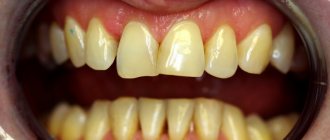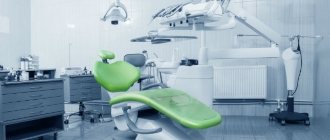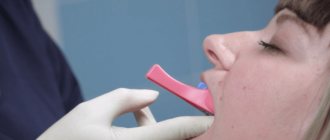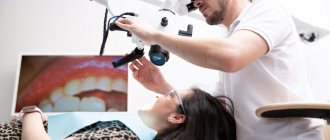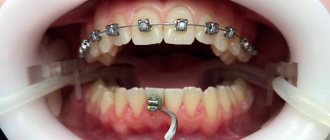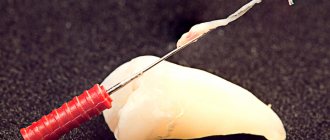Author: ProfGid
A prosthetic dentist or orthopedic dentist is a specialist who is approached for artificial reconstruction of teeth when there is no way to cure and preserve them. Thanks to modern technologies, such a doctor can restore oral health and a beautiful smile to any patient. The profession belongs to the category “ person – person ”. By the way, in 2022, the ProfGid career guidance center developed an accurate career guidance test. He himself will tell you which professions are suitable for you, and give an opinion about your personality type and intelligence.
Short description
An orthopedic dentist first receives a general dental education and then studies his future specialization in depth. He is responsible for all stages of selection, preparation and installation of dentures in their modern variations. This is one of the most sought-after dental profiles on the labor market, as it allows both to restore full functionality of the jaw and to give the patient a beautiful smile.
Acquired skills
During the training process, residency offers the future specialist to fully master all the skills necessary for professional activity and consolidate the acquired knowledge in practice. Thus, the future orthopedic dentist will be able to:
- determine how mobile the tooth is;
- establish the condition of the oral mucosa, determine how pliable and mobile it is;
- probe and determine the condition of periodontal pockets;
perform eclectic diagnostics, provide high-quality anesthesia to your patients;- make two-layer or regular impressions of teeth on plaster or elastic masses;
- carry out complete preparation of the patient’s oral cavity for prosthetics, which includes the treatment of diseases of the oral organs;
- prepare the crowns and roots of teeth for the upcoming installation of dentures;
- install plastic, stamped or solid dental crowns, install pin dentures;
- apply splints made of various materials;
- perform aesthetic modeling of future prostheses, etc.
The skills that a resident acquires during the training process allow him to become a qualified specialist.
Features of the profession
Not every person manages to keep their teeth healthy throughout their life. However, many technologies and materials for dental prosthetics can effectively solve this problem. And if decades ago dentures did not look very beautiful and did not always take root, modern technologies significantly reduce the risk of implant rejection and make it possible to give the dentition an aesthetic, natural look. A prosthetic dentist is fluent in all methods of restoring lost teeth, and his main job responsibilities are as follows:
- examination of the patient, collection of anamnestic data, selection of prosthetic methods suitable for a specific individual case, counseling the patient;
- taking dental impressions;
- production of prostheses from modern materials using high-tech equipment;
- installation of pins in the patient’s jaw, fitting of dentures;
- temporary installation of dentures, correction of detected imperfections;
- securing prostheses for permanent wear.
Dentures can be removable, fixed, conditionally removable, these can be implants, bridges, inlays, crowns. Some technologies gradually cease to be used, and they are replaced by new, more advanced ones. But, in any case, only a professional prosthetist dentist can choose the optimal option for any patient with impaired chewing function or complaints of cosmetic defects in the dentition.
Preparing for an appointment and how to see a doctor
It is not recommended to drink alcohol before seeing a specialist. The presence of alcohol in the patient's blood negatively affects the effect of anesthetic drugs. If the patient is sick, then you should postpone your visit for a while. Before coming to the dental office, you should thoroughly brush your teeth. Therefore, it is advisable to discuss the time of your appointment with the dentist in advance.
At the first consultation, the doctor must determine the degree of damage to the patient’s masticatory apparatus. Before starting orthopedic treatment, complex surgical and therapeutic treatment of the oral cavity is carried out. This makes it possible to carefully prepare the soft and hard tissues of the patient’s maxillofacial area for upcoming procedures. Treatment of the following diseases is mandatory:
- Pulpitis,
- Caries,
- Scar changes in the mucous membrane,
- Stomatitis, gingivitis, periodontitis.
During the appointment, the orthopedic dentist examines the patient’s oral cavity and listens to complaints. The inspection can be visual and instrumental. Next, the doctor takes impressions and photographs the dentition. If necessary, a consultation with a dental surgeon is scheduled. Based on the data obtained, the doctor draws up a further treatment plan for the patient.
First appointment with an orthopedist
Patients are often interested in how the first examination by an orthopedist goes in order to have a rough idea about it, so we will identify the main points that accompany the first appointment with the specialist in question:
- visual assessment of the anatomical structure relevant to the skeletal system (correctness or irregularity), this action is especially important in the case of examining a newborn child;
- determining the range of motion relevant to the affected joints;
- appointment of fluoroscopy, on the basis of which the alleged diagnosis can be clarified or refuted;
- complex forms of pathology may indicate the need for such research methods as CT and MRI (which, respectively, defines computed tomography or magnetic resonance imaging).
Tests prescribed by an orthopedist
Despite the profile of this specialist, which, as one might mistakenly assume, excludes tests as a necessity to complement the overall picture of the disease, one cannot do without their traditional and specific forms here. In particular, the orthopedist may need the results of the following tests:
- general analysis of urine and blood;
- data regarding blood clotting time;
- data on activated partial thromboplastin time;
- prothrombin index, as well as prothrombin time and prothrombin time + fibrinogen.
Advantages and disadvantages
pros
- A prestigious, in-demand profession.
- High salary level.
- Possibility of retraining in related areas of psychology.
- The opportunity to see the real result of your work.
Minuses
- The need to work with the dental cavities of different patients and, as a result, the need for the absence of disgust.
- The need to constantly monitor the development of new technologies and news from the world of dentistry.
- Quite a high level of requirements for specialists.
What determines the cost of services?
The cost of treatment by an orthopedist will depend on several factors:
- Choice of methodology .
The most expensive today is considered to be implantation with fixation of a zirconium dioxide crown. The cost of the service in this case will start from 15 thousand rubles. The most affordable treatment option is the installation of a crown or bridge, the price of which starts from 5 thousand rubles. - Workload . The more destroyed units need to be restored, the more material will be needed to make structures. For example, the same bridge for one tooth will cost from 5 thousand rubles, and for two crowns, the cost will increase to 8 thousand rubles.
- Material of manufacture . When using expensive materials, the final cost of the product and service will be significantly higher than when using cheap options. So, a metal crown will cost 1,500 rubles, while the cost of a ceramic one starts from 6 thousand rubles.
Orthodontic treatment is a mandatory procedure for edentia, which will not only restore the aesthetics of the smile, but also normalize the natural functionality of the dentition.
Average prices
The cost of services of a specialist in this area is determined by several main factors:
- The method chosen for the work. Implantation using fixation of zirconium dioxide crown is the most expensive. The average cost of such services today is set at 15,000 rubles .
- The total amount of work performed. Depending on the volume of dental units being restored, the total cost of the work is determined. In this case, the cost of manufacturing and installing a bridge varies from 5,000 to 8,500 rubles.
- Material used in manufacturing. The cost of the material is the determining factor in setting the price of the product. A metal crown can cost 1,500 rubles , while a ceramic crown will cost 6,000 or more.
Important personal qualities
A prosthetist dentist is required to be responsible, attentive, collected, focused, and patient. In terms of the level of attention to detail required, his work is close to that of jewelry; making mistakes and carelessness in it is unacceptable (especially considering the high cost of consumables). In addition, like any doctor, such a dentist must have certain empathy abilities, a desire to help people, and the ability to find a common language with them. He should also be characterized by a desire for constant development and self-improvement.
Why is it important to see an orthopedist on time?
Let's not dwell on the unsightly appearance of the smile of a person who has missing teeth. Although this fact is very important. Let's talk in more detail about the problems that result from complete and partial adentia. Among them:
Difficulty chewing food. Because of this, the load on the gastrointestinal tract increases. If a patient has a predisposition to stomach diseases, they will certainly arise.- Changing the position of the “neighbors”. As soon as voids appear in a row, neighboring units try to occupy them. Because of this, the bite changes and the teeth become crooked. Such changes complicate hygiene procedures, which is fraught with caries, pulpitis, and gum inflammation. They also have a bad effect on the appearance of the smile and facial proportions.
- Atrophy of bone tissue. If teeth are missing for a long time, the jaw bone in the area where they were previously located begins to sag. This occurs due to the lack of chewing stimulation. Subsequently, atrophy causes difficulties in preparing for implantation - the patient has to undergo a complex osteoplasty operation.
Don't forget to take care of your oral health and restore missing teeth in a timely manner. However, do not give preference to the cheapest techniques. Ideally, after applying dental orthopedics, the functions of the tooth will be completely restored.
Training to become a prosthetist dentist
In order to have the opportunity to immerse yourself in this profession, you must obtain a higher medical education in the general profile of “Dentistry” ( specialty code - 05/31/03 ). To do this, you need to take the Unified State Exam in the Russian language, chemistry and biology or physics (each university sets the exact list of disciplines individually).
Training is most often carried out in a full-time format; some universities offer part-time and part-time education. It lasts 5-6 years, after which you will need to complete a residency in your specialization to gain deeper practical skills, knowledge and abilities.
Career
in the same position throughout his work history , but, as his skills improve (and move to different clinics), his income increases. Or he can become the head of the department, then, after some time, receive the position of deputy chief physician of the clinic, and then become the chief physician . A faster option for this career advancement has already been mentioned - this is opening your own medical institution, but it will require financial investments and the solution of many organizational issues. With a focus on research and development, an orthopedic dentist can become a candidate, and then a doctor of science .
A little bit of history
The history of orthopedics goes back a long way. The first prosthetics, made by ancient orthopedic masters 4.5 thousand years ago, were discovered during excavations in Mesopotamia and Ancient Egypt. They used gold wire as a fixation element.
The founder of modern dental orthopedics is considered to be the Frenchman Pierre Fauchard, who wrote the manual “Dental Surgery...”, published in 1728.
Fauchard was responsible for the development of some methods of prosthetics, in particular, fastening prostheses with springs, correcting the position of units with ligatures, and the idea of pin structures.
At first, orthopedists dealt exclusively with prosthetics. But as practice has shown, this alone is not enough to achieve a high-quality and sustainable result.
Modern orthopedics, in addition to prosthetics, includes the diagnosis and prevention of pathologies of the jaw system.

